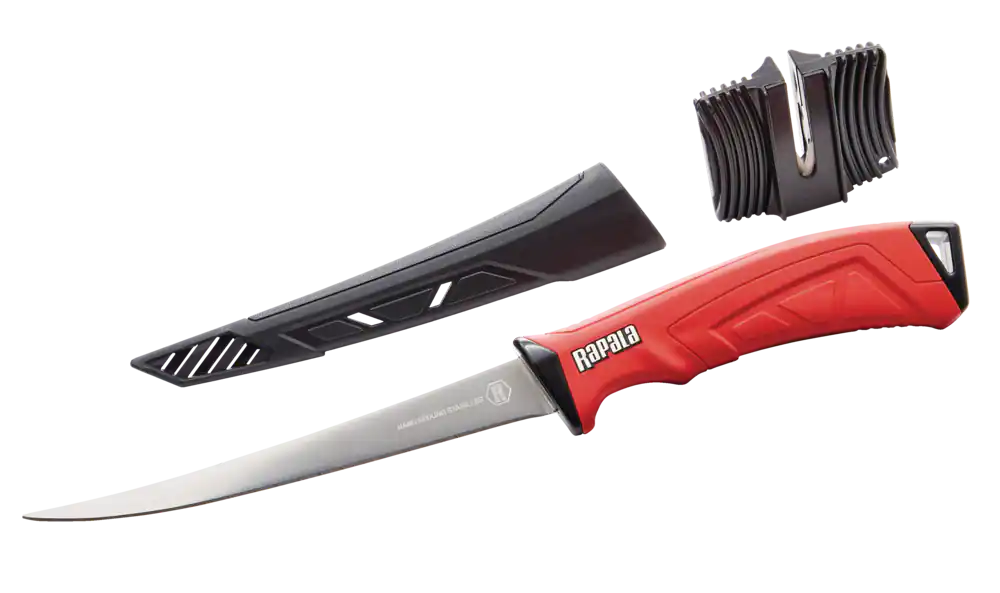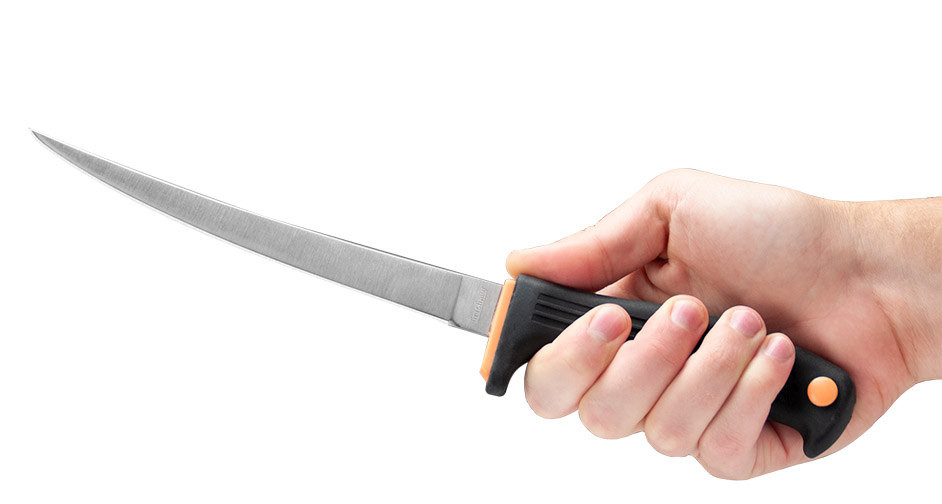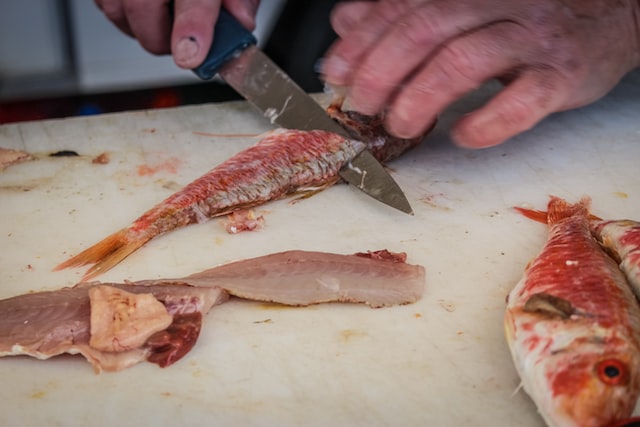Looking for a reliable knife to fillet that delectable seafood you are preparing? Having a fillet knife that lasts a long time is nice when you’re out on the water. But how would you know if your knife is ready for another outing? Is there a good way to maintain your fillet knife? What about sharpening and honing? In this article, we’ll discuss all of these questions in detail. So that when the next time comes around, your fishing adventure will be just as fun as ever!
~WHAT MAKES A FILLET KNIFE DULL?~
Fillet knives are essential for anyone who loves to catch fish. However, catching fish is not the only thing that fillet knife are used for. It is also used as a type of knife that you can use in butchering or skinning animals such as deer and elk. In recent years, it has become more standard to find individuals using their fillet knife for further purposes other than just cutting through fish bones.
While this may appear like an effortless way to cut down on costs, it can actually cause damage to your blade. Especially if done incorrectly or without proper care and attention given by the user themselves so that they do not end up having any issues when trying out their newly purchased item from online stores.

🟪 Using the knife for other functions
If you’re using your fillet knife for functions other than filleting, it will become dull. This is because the blade is designed to be sharpened on one side only, and there are sharpening tools available to help you remove any excess metal if needed. A dull blade may seem like an easy fix. But with a sharpened edge, your fillet knife will be more effective and safer to use over time.
🟪 Cutting through hard bones
Cutting through hard bones that are not meant to be cut by the fillet knife causes the blade to get dull. The rationale for this is because the blade has no manner of removing the meat from inside of these bones, and it can only saw at them. This puts a lot of pressure on your knife, causing it to dull quickly. You could use a saw instead. But they’re more challenging to use, especially if you’re trying to work in small spaces or with slippery fish bones.
🟪 Rust and corrosion
Rust and corrosion can cause a blade to lose its edge. Make sure that your fillet knife is dry before you put it away. You can use a cloth to wipe the blade clean, or you can use a towel to dry the blade. If the knife begins to get dull, it should be sharpened immediately before continuing to use it. It’s vital that fillet knives remain sharp because if they go dull, you may end up losing a finger!
~IMPORTANCE OF HAVING A SHARP FILLET KNIFE~
The first rule is that your fillet knife needs to be sharp. This means it needs to shave even the densest and scaley of fishes.
The second rule is that this sharpness should extend beyond the cutting edge of your knife. In other words, if you cut through a tomato with your fillet knife, the edges of your tomato will be jagged and torn up. If you cut through a potato with it, those same edges will still be rough and torn up. But if you were using an ax instead of a blade (or had somehow managed to make both blades out of titanium), then there would probably not even be any damage done at all.
So how do we get around this problem? We sharpen our knives regularly and sometimes very often! We use stones explicitly made for this purpose. They’re called “stones” because they’re made out of stone quarried from quarries located somewhere far away from here so that nothing wrong can happen during transportation. Except maybe some slight damage such as bumping into things along their way back home again after having traveled all over creation looking for raw materials needed for making these particular type.
~BEST WAY TO SHARPEN FILLET KNIFE~
Use the sharpening rod on the blade, moving from top to bottom until you have sharpened it all. Then start over again by going from bottom to top, using a little more pressure than before. This will cause your knife’s edge sharper than ever and further reduce any potential dull spots or points that might have been missed during the first pass at sharpening your knife. When done with that pass, move on down toward one of those dull spots that were missed earlier in order not only to make them look better but also provide extra strength where needed most the blade itself!
~HONING A KNIFE~
Honing is not sharpening, and it’s not the same as sharpening. It is more like maintenance, a way to keep your blade in good shape and stay super-sharp.
Honing isn’t just for fillet knives, though. You can use a honing rod on any blade, including kitchen cutlery like chefs and paring knives. If you don’t have access to one yet (and why wouldn’t you?), just make sure that whatever blade that needs honing has been cleaned well beforehand. Then, apply some oil or WD-40 over its surface. The latter will help prevent rust from forming on metal surfaces and run the flat side along its spine until you feel results.

🟪 Using steel or ceramic
A steel or ceramic rod is a great way to keep your fillet knife sharp. When you finish using it, simply place the knife on top of the metal rod and let it rest for several minutes. This will prevent any damage while your knife rests on its edge, keeping it ready for later use.
If you have old-fashioned steel, just wipe off any grime before using it! Don’t worry about cleaning up after yourself if you have a new ceramic rod (or any other type). Just leave it in place until next time!
🟪 Storing
It is essential to keep your knives separate from other utensils, as you can sharpen them more quickly and effectively. Keeping them away from heat, moisture, and direct sunlight will also make it easier to sharpen them when they need it most. For example, when you’re cooking dinner or prepping food for a party. It’s also important not to store your knives together with other tools because they may get dirty if used in conjunction. If this often happens enough (and let’s face it: who has time for that?), consider putting all of your blades into one block or magnet strip instead so they don’t get mixed up during cleaning sessions.
🟪 Cleaning
Clean the blade after each use. Use water and a mild detergent to clean the blade, then dry it with a soft cloth.
Dry your knife handle thoroughly with a towel before storing it for future use. You don’t want to risk rust forming on your prized fillet knife!
Don’t use dishwashers or knife sharpeners when cleaning any sharp tool — they’re too powerful for delicate pieces like this!
~SHELF LIFE OF FILLET KNIFE~
Regularly sharpening the blade will ensure that your tool stays in good shape and works as intended. There are two main methods for sharpening a fillet knife: a honing rod or an abrasive surface like sandpaper or diamond plates (but not both). Honing rods are typically used on commercial blades and come in different sizes depending on how much metal is removed from each stroke; when choosing one, pick one with a fine enough tip so you can get into all of the nooks and crannies without having to push too hard against resistance from within them.

The first step before putting any sharpening rod into action should be cleaning off any debris from around pins before starting anything! This step is essential because it prevents any dirt buildup, which could cause rusting down the line soon enough; otherwise, there wouldn’t even be any point in making modifications since nothing would work correctly anymore!
After removing whatever dirt might still exist inside this area where we’re trying out our new implement, whether it’s a woodblock/sponge combo or something completely different, we put everything back together just like before until now. Instead, go ahead and place some water overtop since both options seem pretty similar except maybe slightly less messy looking than what normal folks might expect when getting started.
~BEST FOOD TO USE A FILLET KNIFE~
Fillet knives are designed for fish, but you can use them for all kinds of meat and poultry. While a fillet knife is not the only type of knife you’ll need in your kitchen, it is a very important one. So which foods should you cut with this blade? We’ve got the answers here:

🟪 Fish
If you’re looking to start cooking fish, here are some tips for using a fillet knife:
Fillet knives are perfect for slicing up whole fish. You can use them to cut the five most common types of fish into pieces: steaks, filets, and fillets. To clean an entire whitefish like catfish or flounder (or any other similar type), start by cutting off the gills and fins with kitchen shears or clippers. Then use your fillet knife to remove all of the meat from inside the body cavity before cutting off its head and tail with another sharp knife. A chef’s knife works best here because it has more reach than your filleting tool.
🟪 Chicken
Use your fillet knife to remove the skin, bones, and meat of a chicken:
- Cut off the legs along with the thigh and drumstick.
- Use a sawing motion to separate each piece from its bone.
- Cut down along each side of the breastbone and slice off as much of it as possible with your knife.
Cutting chicken breasts into smaller pieces is another easy task for a fillet knife. Place one hand on top of both sides of the breast while holding down any remaining pieces with a finger or thumb from your other hand. Slice straight through horizontally using long strokes, so you don’t hit yourself on anything sticking out from underneath.
🟪 Meat
If you’re preparing meat, your fillet knife will be your best friend. Meat is a hearty meal that can take a lot of time to prepare. It’s important to use the right tools when preparing it so as not to lose any of its flavor or moisture while cooking. This means using a sharp knife like the fillet knife! A good fillet knife should have an ergonomic handle and blade that won’t bend or break when you’re cutting through tough meat with it.
🟪 Turkey
Turkey is a great food to use a fillet knife on. You can use the fillet knife to cut the skin off of the turkey, and then you can also use it to cut up your turkey into individual pieces. In fact, this is probably one of the most popular uses for a fillet knife!
🟪 Pork and beef
When it comes to pork and beef, fillet knives are particularly useful for removing the skin from large cuts of meat. This is because a fillet knife is sharp enough to cut through skin without tearing it, unlike regular chef’s knives or paring knives. They’re also great for cutting into smaller pieces to cook your pork easily and efficiently. If you’re using a roast, for example, instead of cutting it into thin slices with a chef’s knife (which could be difficult), use your fillet knife instead!
~FREQUENTLY ASKED QUESTIONS~
You’ve probably gotten the hang of cooking fish, but do you know the best way to clean and slice that catch? As it turns out, there are considerable extra types of fillet knives out there. They range in size and shape. So, you may need a few different ones for different jobs. In this section, we’ll talk about what types of knives you should buy (and how many), what to look for when buying them, and how to keep them sharp!
🟧 How many types of fillet knives are there?
There are a number of distinct types of fillet knives, but these can typically be broken down into two categories: one-sided and two-sided.
One-sided (or straight) blades are made for fish with bones and scales, while two-sided blades are intended to handle both situations. This means that you should always have at least one two-sided blade in your arsenal since it will come in handy nevertheless of what kind of fish you’re cutting up.
Two main types make up the one-sided category: straight and curved. Straight blades offer little control over where they cut the meat because they follow along the length of the spine. Curved blades allow for greater precision when performing cuts on smaller fillets like sardines or mackerels that aren’t as long as some others might be. In addition to these two types within each category, there are also scalloped edges that help keep the skin on filets intact during the cutting process, so not all pieces need removal before cooking begins!
🟧 How do you know which knife is best to use?
The size of the knife is determined by the size of the fish you’re filleting. If you’re working on a large fish, like a salmon or tuna, use a longer blade so that you can easily cut through its body. Conversely, if you’re working with a smaller fish like halibut or trout, it’s best to use a shorter blade so that there’s less risk of damaging any bones inside.
If you have never used a fillet knife before and aren’t sure what kind is best for your needs, ask an experienced friend or family member for advice about which blades would suit your particular situation best.
🟧 What should I examine for when buying a fillet knife?
When you’re shopping for a fillet knife, there are several things to consider. First, look for a knife with a sharp edge. It’s hard to enjoy filleting if you constantly struggle with dull blades! Next, make sure that the knife feels comfortable in your hand. You’ll want to be able to maneuver the blade easily and comfortably without having to get used to it first.
Finally, look for quality materials in the handle of your new fillet knife. This is where most injuries occur during use, so make sure there’s nothing too weak about it!
🟧 Where is the best place to sharpen my knife?
There are lots of ways to sharpen a knife, but the basic principle is always the same. You’re trying to create a beveled edge that will slice through food more cleanly and easily. This can be done with a whetstone, sharpening rod, butcher’s steel (you guessed it), knife sharpener, or even a specialty stone.
So which tool is best? It relies on how much span and effort you want to put into keeping your knives sharpened and your budget for equipment and supplies. But rest assured: any of these options will get the job done!
🟧 What are the best recommendations?
For beginners, a fillet knife with a flexible blade is your best bet. It will give you the control you need to cut through fish and other meats without damaging the meat or yourself.
For professionals, a straight-bladed fillet knife can be great for cleaning large quantities of fish at once. Some people prefer these because they’re easier to use on larger fish than those with flexible blades.
When it comes to serrated blades, there are many options out there; some are better than others! The most significant thing when choosing one is finding one that fits comfortably in your hand and has a good grip (to prevent slippage).
🟧 What are the accessories needed?
Don’t forget the accessories! A good fillet knife is only as good as the accessories you have to go with it. You will need a good-quality fillet glove, apron, and bib.
A filleting board is an essential tool for all fishermen and women. The best material for these boards is wood or plastic, not metal. This is because they can get sharp from constant use and puncture your gloves when working with a knife. Wood also has better insulating properties so that heat doesn’t transfer from hot knives to your hands as easily.
You can click here to know the best cutting board!
~BOTTOM LINE~
With a bit of care, your fillet knife will last a lifetime. If you are not using it regularly, take it to an expert who can sharpen it properly and keep it in good condition. Taking care of a fillet knife is important so it can keep slicing meat clean and precisely. If your knife doesn’t have any rust, then you are doing good. However, there are some basics that you have to follow every so often in order to keep your knife as good as when you bought it. Whether you prefer traditional or electric, a fillet knife will be one of the most frequently-used tools in your fish prep arsenal.
